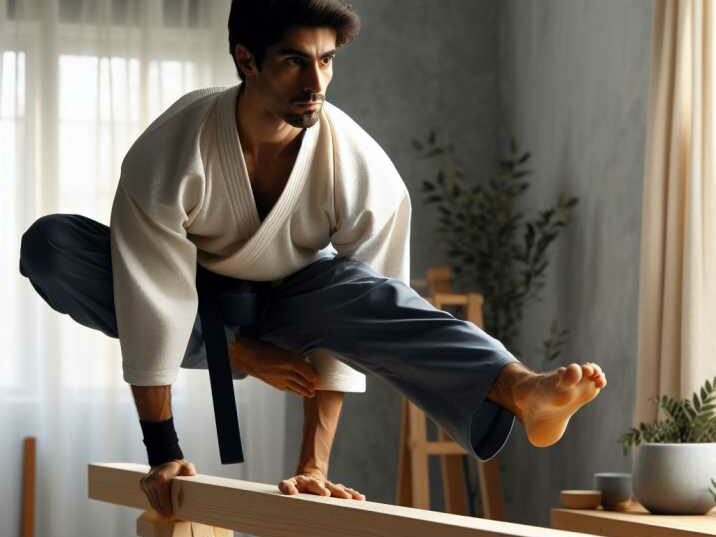DIY Martial Arts Obstacle Course at Home Practice
Table of Contents
Introduction
Embarking on a journey to master martial arts from the comfort of your home is an exhilarating endeavor. This comprehensive guide will walk you through the process of creating your very own DIY Martial Arts Obstacle Course, designed for both beginners and seasoned practitioners. Unleash your inner warrior and elevate your martial arts skills in the most enjoyable way possible.

Channeling Focus: The Importance of a DIY Martial Arts Obstacle Course
Why Opt for a DIY Obstacle Course?
Before we delve into the nitty-gritty details of crafting your obstacle course, let’s explore why opting for a DIY approach is not only cost-effective but also adds a personal touch to your training routine. Engaging in the creation process fosters a deeper connection with the course, making your practice sessions more meaningful.
Benefits of Home Practice
In a world that often demands our time and energy, having a dedicated space at home for martial arts practice is invaluable. Discover the numerous benefits of a home-based obstacle course, from flexibility in training hours to a personalized environment that promotes focus and discipline.
Crafting Your Martial Arts Haven: Step-by-Step Guide
Setting the Stage
Begin your journey by designating a suitable space for your obstacle course. Whether it’s a backyard, garage, or living room, ensure ample space to move freely and execute various maneuvers. This step is crucial, as it sets the foundation for the entire DIY project.

Essential Obstacle Components
Every obstacle course needs key elements to challenge and refine your martial arts skills. Incorporate elements like balance beams, agility ladders, punching bags, and foam pads to create a diverse and engaging course. This not only adds variety but also targets different aspects of your training.
Safety First
Before diving into the physical aspects of your obstacle course, prioritize safety measures. Ensure that all equipment is secure and stable. Use soft materials, such as foam or padded mats, to cushion potential falls. Safety should always be a top priority to create a worry-free training environment.
Personalizing Your Course
Make your obstacle course uniquely yours by adding personal touches. Incorporate elements that align with your martial arts style or add motivational quotes and visuals. Personalization enhances the overall experience and encourages a sense of ownership in your training space.
Navigating the DIY Jungle: Tips for Success
Start Simple
For beginners, simplicity is key. Begin with basic obstacles and gradually increase complexity as you become more comfortable with the course. This approach ensures a gradual progression in your martial arts journey.

Incorporate Challenges
Make your obstacle course dynamic by including challenges that target different aspects of martial arts. Integrate speed-focused obstacles, precision-based challenges, and endurance elements to create a well-rounded training experience.
Regular Maintenance
Just like any other aspect of your home, your obstacle course requires regular maintenance. Check for wear and tear, replace any damaged equipment, and ensure the overall safety of the course. A well-maintained course ensures longevity and continued enjoyment.
Unlocking Your Potential: Benefits of a DIY Martial Arts Obstacle Course
Enhanced Flexibility
One of the primary advantages of a DIY obstacle course is its flexibility. Tailor your course to suit your schedule, allowing you to practice martial arts at your convenience. This flexibility is particularly beneficial for individuals with busy lifestyles.
Improved Focus and Discipline
Creating and navigating your obstacle course demands focus and discipline. As you progress through the various challenges, you’ll find an enhancement in your ability to concentrate, a crucial skill in martial arts and daily life.
Increased Physical Fitness
Engaging in a diverse range of obstacles naturally improves your physical fitness. From cardiovascular benefits to increased strength and flexibility, the DIY martial arts obstacle course provides a holistic approach to fitness.
Bringing Your DIY Creation to Life: Unleashing the Warrior Spirit
Starting Your Training Session
As you stand at the entrance of your meticulously crafted obstacle course, take a moment to center yourself. Breathe deeply, channeling the warrior spirit within. Visualize success and approach each obstacle with determination and focus.
Progression and Mastery
Track your progress as you navigate the course regularly. Set personal goals and milestones, celebrating each achievement. The sense of accomplishment gained through mastering your DIY obstacle course contributes significantly to your overall martial arts journey.
Conclusion:
DIY Martial Arts Obstacle Course at Home Practice is a journey that extends beyond physical training. It’s about unlocking the warrior within, fostering discipline, and enjoying the process. As you embark on this adventure, remember that every obstacle conquered brings you one step closer to mastering both the course and your martial arts skills. Unleash your potential, and let the warrior spirit guide you on this exciting path of self-discovery.
Frequently Asked Questions (FAQS)
1. Can I create a DIY Martial Arts Obstacle Course indoors?
Absolutely! Whether indoors or outdoors, ensure you have sufficient space and consider the flooring to maintain safety.
2. How can I involve my children in creating the obstacle course?
Make it a family activity! Encourage creativity, and let your children suggest elements for the course. It’s a fantastic bonding experience.
3. What materials do I need for a DIY obstacle course?
Basic materials include agility ladders, balance beams, punching bags, and padded mats. You can tailor the materials based on your preferences and available space.
4. Is it suitable for all martial arts styles?
Yes, the DIY obstacle course is adaptable to various martial arts styles. Customize the challenges based on your specific discipline.
5. How often should I update or modify the obstacle course?
Regularly assess and update your obstacle course to keep it challenging and engaging. Modifications can include changing obstacle placements or introducing new challenges.
6. Can I incorporate technology into my DIY Martial Arts Obstacle Course?
Certainly! Consider integrating apps or videos that provide virtual guidance, enhancing your training experience.
7. How do I ensure the obstacle course remains safe?
Regularly inspect the course for any wear and tear. Ensure all equipment is secure, and use appropriate safety measures such as padding and mats.
8. Is it suitable for beginners?
Absolutely. Start with simple challenges and gradually increase complexity as you gain confidence and skill.
9. Can I share my DIY obstacle course with others?
Of course! Share your creation with friends, family, or fellow martial arts enthusiasts. It’s a great way to inspire and motivate others.
10. How can I stay motivated while using the obstacle course?
Set personal goals, celebrate achievements, and track your progress. Involve friends or family to create a supportive and motivational environment.
11. Are there any specific age restrictions for using a DIY obstacle course?
Not at all. Adjust the difficulty level based on age and skill, making it suitable for all ages.
12. Can I create a temporary obstacle course?
Certainly. Consider using easily movable elements so you can set up and dismantle your obstacle course as needed.


